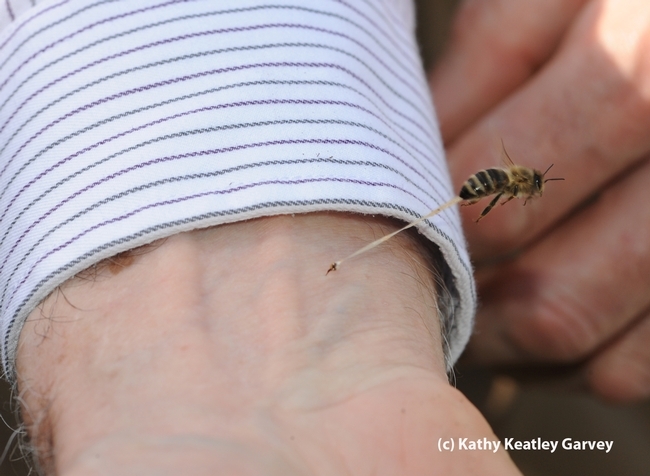Chris saw it first.
This morning Chris Mussen of Davis contacted his father, Extension apiculturist Eric Mussen of the UC Davis Department of Entomology, and told him that the photo of him being stung by a honey bee made the Sacramento Bee's list of top 15 2012 stories.
Well, a son should recognize his father's wrist anywhere, right?
Right.
The story behind the photo: Eric Mussen and I were walking in the apiary of the Harry H. Laidlaw Jr. Honey Bee Research Facility when he noticed that a bee was about to sting him.
He told me to get my camera ready. My Nikon D700, equipped with a 105 macro lens and a motor drive), was strapped around my neck, where a camera ought to be.
I caught the image (actually four of them as my camera shoots eight frames a second) and the rest is history. The photo initially won the first-place (gold) award in a feature photo contest sponsored by the international Association for Communication Excellence in Agriculture, Natural Resources, and Life and Human Sciences.
The Sacramento Bee featured it, and later it was selected one of the Huffington Post's most amazing photos of 2012 and "Picture of the Day" on a number of websites.
It depicts a Carniolan bee reared by bee breeder-geneticist Susan Cobey. At the time the image was taken, the bee was defending its hive.
Which is what bees do.
Usually a bee sting results in a clean break, Mussen said. This one shows the bee trailing its abdominal tissue, aka guts.
I earlier wrote about "The Sting" in a Bug Squad blog.
The thing is, people are still saying that I must have spent the day torturing bees to get that shot.
Not true. (Fact is, I've never killed a bee in my life except for the one I stepped on in Hawaii.)
Now folks are jokingly telling me I was torturing Eric Mussen.
Not true, either. He's been stung countless times, and each time, he simply scrapes off the sting with his fingernail.
Which is what beekeepers do.
Attached Images:
